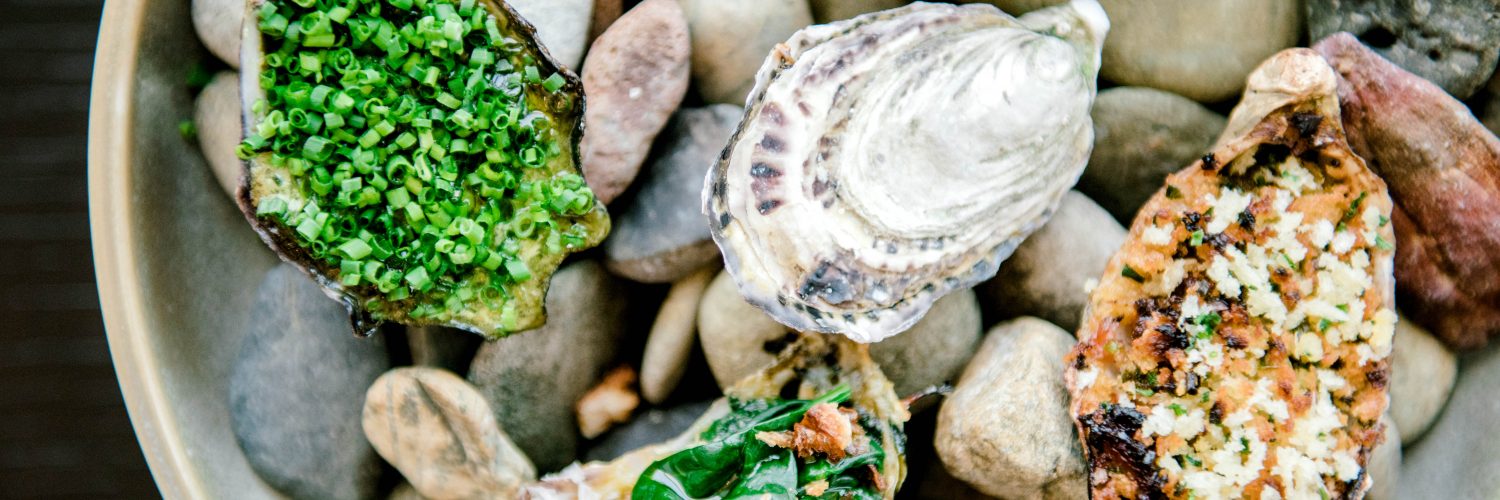We’re truly blessed to have a coastline that is abundant with freshly grown oysters, so let’s get into all things about these bivalves.

For seafood lovers, choosing your favourite is oyster is almost like choosing your favourite travel destination, (almost) impossible. But nevertheless, our oyster experts were up to the task. Peter Robertson, Executive Chef of Flying Fish, and Uday Huja, Executive Chef of Nineteen at The Star, reveal their thoughts on Aussie oysters and which is their go-to.
Rock Oysters
What is the typical Rock oyster flavour profile?
Peter Robertson (PR): The flavour profile for all oysters the world over is the same and each oyster displays the same flavour characteristics, how much or little of each is dependent on species, environment and husbandry. Then to a certain degree it’s down to personal preference as to what your best oyster will be but the characteristics you will taste are:
- Brine
- Creaminess
- Sweetness
- Minerality (yes, we get to use that word as well, not just every sommelier ever)
- Umami.
Uday Huja (UH): Agreed. When it comes specifically to Rock oysters, I find they’re deep, rich and sweet in flavour, finishing with a slight mineral taste.
When is the best time to eat them?
UH: September to March, or Spring to Winter and North to South along the East Coast of Australia.
What’s so impressive about them?
PR: I like that like all oysters they are representative of where they are from and have flavour characteristics based on the local environment. If the farm is closer to the mouth of an estuary the salinity will be higher and the oyster will be brinier, if there is lots of sea grass and seaweed it will affect the minerality/vegetal levels and if the water is colder, then the oyster will be slightly sweeter. They also pair really well with champagne and the two together are perfect for long boozy lunch or a special occasion.
UH: There’s an incredible variety of flavours that can be found in oysters. An oyster flavour is directly related to its ‘merroir’ or marine environment. Basically, what that means is the taste reflect the waters where it was raised.

How do you like to serve them?
PR: Natural and chilled just before opening, with some form of acid. I’m not really a purist here so think outside of the mignonette, definitely vinegar based, but some background sweetness and flavours that complement how you like to cook. So, you might go ginger and shallot if you tend to be more eastern influenced or fresh horseradish, cabernet vinegar with a touch of maple if you tend to cook more western. Oh, and Kilpatrick, but that’s a guilty secret.
UH: The purest in me likes to enjoy them ice cold and freshly shucked. However, I have been known to dress them with a Ruinart Champagne Mignonette. I find this can help accentuate the sweetness of the oyster.
Angasi oysters
What is the typical Angasi oyster flavour profile?
PR: The angasi oyster tends to be a bit more vegetal, even towards muddy.
UH: full-bodied, finely textured and rich in flavour.
When is the best time to eat them?
UH: The peak season for Anglis is May to November.
What’s so impressive about them?
PR: Native to Australia! Closely related to Belon oysters from Europe but we can claim this one as our own, due to massive over fishing the majority of the southern oyster reef beds have been dredged and the stocks almost fell over, we have a few producers farming them now but they are still pretty rare to find in markets.
UH: Their size. They are a large ‘flat’ oyster related to the Belon oyster from France. Both are recognised by oyster connoisseurs as some of the best in the world.
How do you like to serve them?
PR: I like them fresh. If someone gave me 50 dozen of these to open, I may well retire early! Like most things native to Australia they are pretty tough. The hinge won’t pop without a fight and then they can be the size of a bread plate, so you’ll want an oyster knife with a pretty long blade.
UH: Their large size lends them to cooking, so I roast these in our wood fire oven with great success. Our Smokey oysters at Nineteen at The Star are made with Garlic butter, bacon and barbecue sauce or Rockefeller style with spinach and Pernod.

Pacific oysters
What is the typical Pacific oyster flavour profile?
PR: Similar to the Rocks but tend to be more on the briny side and not as sweet.
UH: Fresh and salty flavour, with a crisp clean finish.
When is the best time to eat them?
PR: Right now! They are as good as they get
What’s so impressive about them?
PR: Pacific’s are weird for me, I prefer Rocks, yet my best ever oyster experience was standing waist deep on an oyster lot in Coffin Bay eating Pacific’s. I think this scenario is similar to why that bottle of reasonably priced French wine tasted so good when you were on holidays in France but would maybe disappoint if you brought the same bottle back home, the environment probably played a role there.

UH: Their size and “deep cup” shell means you get a mouthful of beautiful ocean flavour in every bite.
How do you like to serve them?
PR: The same as Rocks.
UH: Chilled with a squeeze of lemon, a dash of Tabasco and a cold beer. It’s sort of an American thing from my heritage, it is hard to argue with the combination.
And if you had to pick a favourite of the three, which would come out on top?
PR: Rocks for sure, not just because I prefer the flavour, but I was born and raised in Sydney and I like to support the small local communities up and down the east coast.
UH: Sydney Rock Oysters are my favourite. We have developed a ‘Oyster Journey’ at Nineteen at The Star allowing our guests to taste several featured oysters at their peak from different estuary’s. Each has a particular flavour profile and delivers a unique culinary experience.
You can get a taste of all these delicious oysters at Flying Fish in The Star Sydney, Nineteen at The Star Gold Coast or Black Hide by Gambaro at Treasury Brisbane and decide for yourself.






